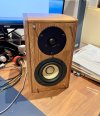I'm a mechanical engineer and in recent years have started paying more attention to speakers after years of general listening to music. I'm interested in the science and frequency response along with other aspects of a "good" speaker. But I have a hard time following reviews of people who judge speakers only by their ears and nothing scientific. Okay I get that. But what do all the terms used by these speaker reviewers really mean? What does "spatial" mean? etc.
Well today I tested out a used set of speakers and found something so strong that I wanted to ask what it meant. I put the speakers on my computer desk (not a normal listening position for me).... the vocals sounded like they were coming from an invisible large speaker in between the stereo speakers, which are maybe 3-4 feet apart. Mostly just vocals. Usually I can year all the music coming from each speaker, movement closer, left, right, etc all have an effect, but with these the vocals always came from the center of them. It was amazing. The speakers were a little base heavy so I turned up some EQ in the highs, but the center vocal affect lessened. I tilted them up a bit to be in line with the tweeter and this center vocal affect went away. Put them back flat on the table top and it came back. It has to be tied to the speaker sitting on the table top, so the table top must be vibrating some sound? It's more noticeable at louder volume and lower vocals. I normally put some foam on the bottom of the speakers to isolate, but did not this time. What term do people call this affect where the vocals seem to come from a perfect middle speaker that isn't there? It's kinda nice like this. Is there a definition guide to those words / terms of listening to speakers?
A few years back I tried a set of BW CM1 speakers and the music sounded like it was coming from 1' behind the wall they were in front of, maybe 6" space between them and the wall. That was strange to me. The BW 686 didn't sound like that. So much is room acoustics and placement, but some speakers are less sensitive to this.
The speakers are the Pioneer S-A4SPT-PM which are the ones built from Pure Malt oak barrels about 4" woofer. I saw them 20 years ago in a Pioneer store but couldn't fathom paying $400 a set when I was in my 20's. My curiosity of would these be any good set in and after a while waiting on ebay a set in the US popped up for $320 after some bidding. I know they ship from Japan at a stupid crazy $800 price, and there is a slight updated model without the Kevlar woofer which is suppose to be better. They aren't perfect, and I can't play them too loud tonight with kiddos sleeping but sound good at a low volume.
Thanks in advance
Well today I tested out a used set of speakers and found something so strong that I wanted to ask what it meant. I put the speakers on my computer desk (not a normal listening position for me).... the vocals sounded like they were coming from an invisible large speaker in between the stereo speakers, which are maybe 3-4 feet apart. Mostly just vocals. Usually I can year all the music coming from each speaker, movement closer, left, right, etc all have an effect, but with these the vocals always came from the center of them. It was amazing. The speakers were a little base heavy so I turned up some EQ in the highs, but the center vocal affect lessened. I tilted them up a bit to be in line with the tweeter and this center vocal affect went away. Put them back flat on the table top and it came back. It has to be tied to the speaker sitting on the table top, so the table top must be vibrating some sound? It's more noticeable at louder volume and lower vocals. I normally put some foam on the bottom of the speakers to isolate, but did not this time. What term do people call this affect where the vocals seem to come from a perfect middle speaker that isn't there? It's kinda nice like this. Is there a definition guide to those words / terms of listening to speakers?
A few years back I tried a set of BW CM1 speakers and the music sounded like it was coming from 1' behind the wall they were in front of, maybe 6" space between them and the wall. That was strange to me. The BW 686 didn't sound like that. So much is room acoustics and placement, but some speakers are less sensitive to this.
The speakers are the Pioneer S-A4SPT-PM which are the ones built from Pure Malt oak barrels about 4" woofer. I saw them 20 years ago in a Pioneer store but couldn't fathom paying $400 a set when I was in my 20's. My curiosity of would these be any good set in and after a while waiting on ebay a set in the US popped up for $320 after some bidding. I know they ship from Japan at a stupid crazy $800 price, and there is a slight updated model without the Kevlar woofer which is suppose to be better. They aren't perfect, and I can't play them too loud tonight with kiddos sleeping but sound good at a low volume.
Thanks in advance
Attachments
Last edited:

